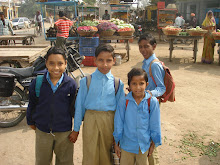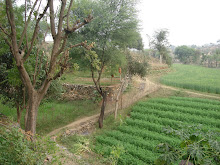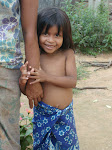Host Partner: Sayhog Sansthan
The Project: Water Harvesting Structure
The Total Cost: 1.5 lakh Indian Rupees
Contribution by Host Partner: 50% materials, scientific and project expertise.
Contribution by Villagers and Beneficiaries: 50% labour, tools and expertise.
10 -12 km outside of Bhinder lies a tribal village of 50-60 famlies named Vaniyatalai. Just outside of the main village portion was where the water harvesting structure was to be built. A trench of 4 feet wide and approx. 30 feet long, was dug across a small dry tributary. For the first week we dug out the trench by hand, using pick axes, and small shovels/hoes. The men mostly dug, while the women filled their Tdagari with sand and dirt. The Tdagari balanced precariously on their heads, the women walked up the small incline to dump the sand and back down to fill it once more. The sand was strategically placed in order to eventually extend the structure and contain the water once the monsoon rains arrived.
This is the second year of drought and once the structure is complete at the end of April, it will hold the water back just long enough to percolate some into parched land and recharge the water table and 5 open wells in and around the village. By the end of the first week, the trench had been dug 1.5 m below the surface to the bedrock. It was now time to lay the foundation stone. With ceremony and blessings, we took part in the laying of the first stone, and cement mixing begun!
The second week on the Project found us mixing cement and hauling stones. The women mixed cement – 60 Tdagari of sand + 1 bag of cement and 20 pails of water. First the dry is mixed and then into a circle with a small well for water, and then the 20 pails of water. Then the dry cement is scooped into the well and from there it sits for 10 – 15 minutes. Eventually, one or two women scoop the cement with a large hoe, another lifts the Tdagari onto the heads of the women who balance it and walk it to the trench. All of us foreign women slopped cement down the back of ourselves more than once!
While the women were doing this, the men moved rocks, big rocks, huge rocks that took two – three men to carry, and 60 kg bags of dry cement. They work very safe here, carefully stepping and moving rocks. They are incredibly resourceful and reasonably fast and making tools and implements to assist them in the labour. After several hours of work we headed up to the village for traditional breakfast of milk and maize and later to another's home for chai. It was hot and by the second week we were better acclimatized, still taking breaks in the shade and consuming lots of water, but move slightly faster, and felt a bit fresher at the end of the day.
There was little English spoken by the people, however through hand gestures and pointing, we were able to converse and share our lives. Amongst the women, we chatted about husbands and children, sisters and mothers. Amongst the men, they spoke about the work, the tools and materials and amount of harvest, rain and flora of the area. A great commraderie was established by the end of the third project day, and by the very last day, tears were shed, and ache in our hearts appeared. I think each one of us would like to return someday, to see the project and hear news of the families, and share space once again.
Tuesday, April 7, 2009
Subscribe to:
Post Comments (Atom)







.jpg)
.jpg)
.jpg)


No comments:
Post a Comment